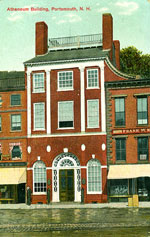 LEGACY
LEGACY

Legacy, Part Four: Portsmouth Athenaeum
Founded as a private library in 1817, the Portsmouth Athenaeum has been a fixture on Portsmouth’s Market Square for nearly 190 years. Supported by its 375 proprietors, the Athenaeum contains a large library of books, manuscripts, and photographs, as well as paintings, sculpture, ship models and a host artifacts devoted to local history. Before his death in 1980, historian Thomas C. Wilson made provisions to donate the Piscataqua History Club collection of books, manuscripts, photographs, and artifacts to the City of Portsmouth. Since he was the spiritual as well as the financial backbone of the club, it disbanded at his passing. The city in turn placed the contents of the library and the artifacts with the Portsmouth Athenaeum. The collection includes two peace conference chairs used by Komura and the largest collection of Treaty of Portsmouth photographs and other illustrations.

Portsmouth Athenaeum, Market Square, Portsmouth, has a large collection of treaty-related materials. Richard Candee collection. View larger image.
From June 16 through November 5,2005, the Athenaeum’s Randall Gallery is hosting “War and Peace: Images from the Russo-Japanese War, 1904-1905.” Lithographs on loan from collector Frederic A. Sharf depict scenes from the war as seen through the eyes of Japanese artists. The images were produced as propaganda to attract support for the war, both from Japanese and from Western nations. The Athenaeum gallery hours are Tuesday and Thursday 1-4 and Saturday 10-4.
Portsmouth Historical Society / Treaty Exhibit

John Paul Jones House of the Portsmouth Historical Society hosts a major treaty exhibit in the summer of 2005. Richard Candee collection. View larger image.
The collections of the Portsmouth Historical Society, founded in 1917, focus on life in Portsmouth and the surrounding region from the first English settlement here in 1623 through the early 20th century. The Society's collections are exhibited in the John Paul Jones House, which has served as the Society's home since 1920. Built in 1758, the Georgian home on State Street is named for the famous Revolutionary War admiral who lived here when outfitting his warship Ranger in 1777. The collections include important examples of locally produced furniture and decorative arts as well as pieces made elsewhere that have played a role in the history of the Piscataqua region.
During the summer and early fall of 2005, two new galleries will hold a single exhibition entitled “An Uncommon Commitment to Peace: Portsmouth Peace Treaty of 1905,” a project of the Japan America Society of New Hampshire, funded by the Center for Global partnership of the Japan Foundation.
A major part of the centennial organized by the Portsmouth Peace Treaty Anniversary Committee, this exhibit at the John Paul Jones House will feature rare images of the war, key participants in the negotiations, the role of New Hampshire, and local events that led to the treaty signing on Sept. 6, 1905. The exhibit will focus on the 30 days of negotiations in Portsmouth and the naval protocol for the formal peace negotiations and the unique informal peace negotiation process hosted by the Governor of New Hampshire and many local people and organizations.
Besides this panel exhibit, the PHS galleries will provide space to show many historic objects including the pen used to sign the Treaty, the chair in which the Japanese diplomat Baron Komura sat, and other objects memorializing the treaty or associated with its participants in 1905. While many artifacts will be loaned from public and private collections, the exhibit will encourage permanent gifts of treaty-related objects to the Portsmouth Historical Society.

Treaty postcard. C. B. Doleac collection. View larger image.
Multi-Track Diplomacy
Although the term had not been coined in 1905, multi-track diplomacy best describes the events surrounding the Portsmouth peace conference. In between the formal direct negotiations, the U.S. Navy and the people of Portsmouth hosted informal meetings, and recreational and social events throughout the local area to foster interpersonal relations between the Russian and Japanese delegations.
This form of peace negotiation using non-formal participants and organizations on many tracks is becoming a new, broader approach to resolving international conflicts, especially when the formal parties are unable to resolve their differences by traditional diplomacy. Portsmouth is not only an example of the ability of local people to influence international diplomacy, but is also a sterling example of multi-track diplomacy before scholarship identified it.

The symbol of the Portsmouth Peace Treaty centennial. Richard Haynes, © Haynes Images.
Portsmouth Peace Treaty Anniversary Committee
The Portsmouth Peace Treaty Anniversary Committee is planning for the 100th anniversary celebration of the signing of the treaty in 2005. The broad-based committee includes representatives of local schools, churches, and businesses, the Portsmouth Naval Shipyard, the Greater Portsmouth Chamber of Commerce, Portsmouth Athenaeum, Portsmouth Historical Society, Green Acre Baha’i School, the Japan-America Society of New Hampshire, the Russia Society of New Hampshire, Portsmouth Marine Society, the Music Hall, Strawbery Banke, and New Hampshire Council for Humanities and many more. For details about the anniversary, visit the main site, portsmouthpeacetreaty.org.
Portsmouth artist Richard Haynes designed the Portsmouth Peace Treaty Centennial symbol used on the header of this website, on centennial banners and posters, and available locally as a fine art print. The design incorporates five themes: The red half-flag on the right represents Japan; the red and blue half-flag on the left represent Russia; the gray dove represents the peace between the two countries; the olive branch represents Theodore Roosevelt; and the gray bell represents the United States Navy who provided the protocols for peace at the Portsmouth Naval Shipyard and announced the peace to the world through the bell; the olive branch of peace, rather than a big stick, represents Roosevelt's peace diplomacy; and the white steeple in the middle represents the North Church of Portsmouth, New Hampshire, symbolizing the role played by the state and many local people who hosted the two delegations and provided informal venues for peace.
